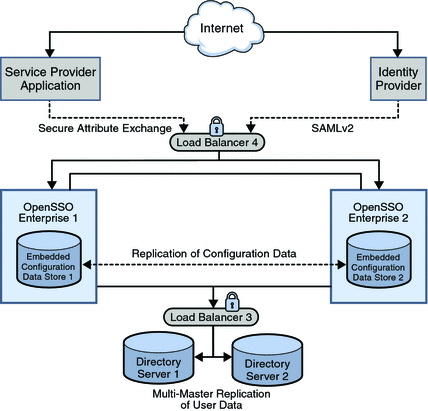Service Provider Deployment
A service provider offers web-based services to an identity. This broad category can include portals, retailers, transportation providers, financial institutions, entertainment companies, libraries, universities, governmental agencies, and other organizations that consume identity information for purposes of access. The following figure illustrates the Service Provider architecture in this deployment.
Figure 2–3 Service Provider Deployment Architecture

The service provider domain in this deployment is sp-example.com. The service provider application represents a legacy system which relies on OpenSSO Enterprise to act as a secure gateway through which identity information can be received from the identity provider. This functionality is provided by the Secure Attribute Exchange feature of OpenSSO Enterprise which uses SAMLv2 without having to deal with federation protocol and processing.
The following list of components will be installed and configured using the procedures documented in Deployment Example: SAML v2 Using Sun OpenSSO Enterprise 8.0.
- Sun OpenSSO Enterprise
-
Two instances of OpenSSO Enterprise provide the core functionality. Each instance is created with a configuration data store. Configuration data includes information about services, administrative users, realms, policies, and more.
- Sun Java System Directory Server
-
Two instances of Directory Server provide storage for user entries that will be created for testing this deployment. User data is accessed through a single load balancer deployed in front of two instances of Sun Java System Directory Server. Both instances of Directory Server are masters that engage in multi-master replication, providing high availability to the OpenSSO Enterprise layer.
- Sun Java System Application Server
-
Two instances of Sun Java System Application Server are installed on the OpenSSO Enterprise host machines into which the OpenSSO Enterprise WAR is then deployed.
- Load Balancers
-
The load balancer hardware and software used for this deployment is BIG-IP® manufactured by F5 Networks. They are deployed as follows:
-
OpenSSO Enterprise Load Balancer
This load balancer exposes the web-based OpenSSO Enterprise console to internal administrators. Alternatively, internal administrators can bypass this load balancer and log in directly.
-
Directory Server Load Balancer
The load balancer in front of the Directory Server instances provides round-robin load balancing and a single virtual Directory Server host name. It detects individual Directory Server failures and recoveries, taking failed servers off the load balancer list.
-
- Sun OpenSSO Enterprise Policy Agents
-
Policy agents are used to restrict access to hosted content or applications. The policy agents intercept HTTP requests from external users and redirect the request to OpenSSO Enterprise for authentication. Web policy agents protect any resources under the doc root of the web container. J2EE policy agents protect a variety of hosted J2EE applications; in this deployment, agentsample is used. The agents communicate with the OpenSSO Enterprise instances through the configured load balancer.
- Protected Resource Host Machine
-
The protected resource host machine contains the content for which access is restricted. BEA WebLogic Server and a J2EE policy agent is installed. Sun Java System Web Server a web policy agent is also installed. Additionally, a sample JSP is installed to act as the legacy application for purposes of demonstrating the Secure Attribute Exchange feature.
For step‐by‐step instructions for deploying these components as illustrated in this chapter, see Deployment Example: SAML v2 Using Sun OpenSSO Enterprise 8.0.
- © 2010, Oracle Corporation and/or its affiliates
